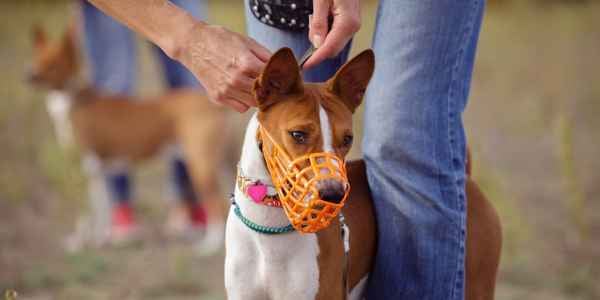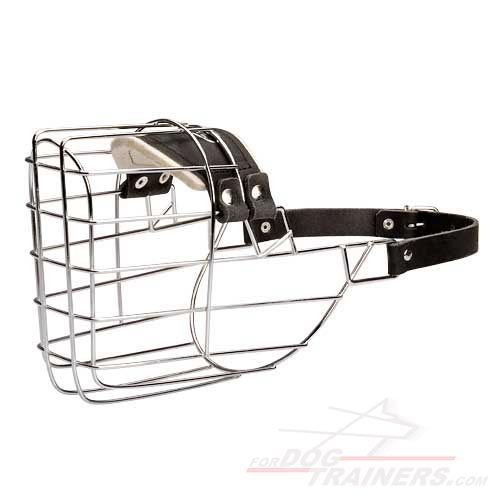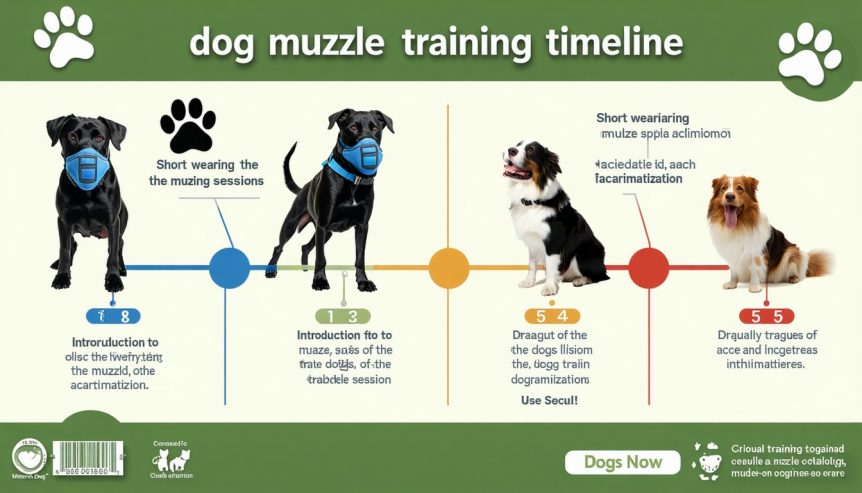Contents
Training Your Dog with a Muzzle
Getting your furry buddy comfy with a muzzle early on is a smart move. Let’s talk about teaching your young pup to see the muzzle as no biggie, starting right from day one.
Puppy Training and Muzzle Introduction
First things first, as soon as that cute ball of fur finds a new home with you, usually around 8 weeks, it’s muzzle time. Getting them used to it early on saves you from future hassles and keeps stress at a low.
- Get a Head Start: Puppies are like sponges between 6 to 16 weeks. They soak up all kinds of new stuff (source).
- Keep it Short: Start with brief moments, let them sniff around, and reward them with treats and affection. Make the muzzle their new bestie.
- Little by Little: Slip some treats inside and let ’em poke their nose in. Slowly get them used to wearing it longer.
- Double Duty: Mix in basic commands like “Sit” and “Come” with the muzzle intro during mealtimes around 8-10 weeks. It’s all about getting used to it and making it fun.
Early Socialization and Training Benefits
Getting your pup to mingle early is super important. Here’s why a muzzle can work wonders while they’re figuring things out.
- Boost Confidence: Ingraining the muzzle into their early life helps build their confidence, making it just a familiar routine item, not stress-inducing.
- Safety First: Meeting new pals, whether they walk on two legs or four, is part of growing up. A muzzle keeps everyone safe as your pup learns self-control.
- All-In-One Training: Think of a muzzle as part of the whole training kit. Combine it with potty and crate training. Crates double as a security zone, helping with everything from toilet training to chilling out during alone time.
From age 6 to 16 weeks, show your pup the whole world—people, other dogs, bustling places, different objects. Making the muzzle a regular part of their adventure tells them it’s like wearing their new favorite collar.
Check out our dog muzzle training guides and think about getting a pro trainer for more savvy steps. Dive into our advice on positive reinforcement techniques for muzzle training.
By starting these helpful habits early, you’ll make sure the muzzle translates to comfort and safety—never stress.
Muzzle Training Techniques
Getting your dog used to a muzzle doesn’t have to be a wrestling match. Let me show you a couple of ways to make it feel like it’s as easy as pie.
Positive Reinforcement Approach

You know how rewarding your dog makes them wag their tails like crazy? That’s your fastest ticket to muzzle acceptance. It’s all about keeping the experience safe and happy for both pup and people (Roundwood Vets).
Steps for Positive Reinforcement Muzzle Training:
- Introduce the Muzzle Gradually:
- Let the dog give the muzzle a sniff like it’s a new toy.
- Toss in some top-tier treats every time they check it out.
- Associate the Muzzle with Fun Activities:
- Keep the rewards coming during play or chill sessions with the muzzle around.
- Talk to them in that silly voice you know they love.
- Short, Frequent Sessions:
- Imagine short episodes rather than a whole season binge-watch.
- Go at the pace your dog sets and keep it cool (Blue Cross).
| Training Session | Duration (Minutes) | Frequency (Per Week) |
|---|---|---|
| Initial Introduction | 2-3 | 5-7 |
| Familiarization | 5-7 | 3-4 |
| Wearing Practice | 10-12 | 2-3 |
Hop over to our step-by-step guide for more.
Conditioning for Comfort and Safety
Think of it as tailoring the perfect outfit for your dog, especially if they’ve got a bit of a bitey side (Argos Dog Training). The right fit keeps them comfy.

Steps for Conditioning:
- Ensure Proper Fit:
- Grab a muzzle that lets them pant and sip some water.
- It should stay on snugly but not squeeze.
2. Monitor and Maintain:
- They can sport a basket muzzle from an episode of their favorite show to a full movie – 60-90 mins.
- Keep an eye out for any red spots or discomfort.
- Clean the muzzle twice a week so it doesn’t turn into a mini science project (Preventive Vet).
3. Incorporate Fun and Relaxation:
- Treats inside the muzzle? Sounds like a mini treasure hunt.
- Let them snack without snapping it shut yet.
- Slowly up the wear time while keeping things chill.
Scour our professional training tips to keep it fun and safe.
With treats and comfort in your arsenal, muzzle training will be just another walk in the park. Scoot over to our dog muzzle training resources if you’re hungry for more.
Types of Dog Muzzles
Picking out the right muzzle is a big deal for your dog’s happiness and protection. Here, we’re gonna chat about two popular choices: basket muzzles and soft muzzles.
Basket Muzzles: A Breath of Fresh Air
Basket muzzles are a top pick for training. These muzzles let your dog breathe easily, sip some water, and munch on treats. A favorite among the basket bunch is the Baskerville muzzle—folks love its comfort and practical design. Plus, they allow for panting, which is super important for cooling off and relaxing (Blue Cross).
| Feature | Basket Muzzles |
|---|---|
| Breathing | Yes |
| Drinking Water | Yes |
| Accepting Treats | Yes |
| Panting | Yes |
| Usage Duration | Long-term |
Need more details on getting your pup used to a muzzle? Check out our dog muzzle training resources.
Soft Muzzles: A Brief Stop

Also known as occlusion muzzles, soft muzzles are something you wanna be careful with. They’re meant for really short times, like a trip to the vet or other quick situations. Unlike basket muzzles, they keep your dog’s mouth from opening all the way, which can raise those stress levels. Don’t use ’em for barking or for a long stint (Preventive Vet).
| Feature | Soft Muzzles |
|---|---|
| Breathing | Limited |
| Drinking Water | No |
| Accepting Treats | No |
| Panting | No |
| Usage Duration | Very short-term |
For tips on getting your dog comfy with a muzzle, check out our dog muzzle introduction programs.
Knowing the difference between these muzzles will guide you in picking what fits your dog’s needs best. Want to dive into training methods? Visit our page on dog muzzle training: positive reinforcement methods, or look into dog muzzle professional training for expert help.
Best Practices for Muzzle Training
Step-by-Step Training Guide
Getting your dog used to a muzzle takes a little bit of gentle patience. Check out this step-by-step guide to help you out:
1. First Impressions
- Show your pup the muzzle without putting it on. Let them sniff and explore.
- Give them treats and cheer them on whenever they give the muzzle a curious look.
2. Making Muzzles Fun
- Stick some goodies inside the muzzle and let your dog munch away. This helps them see the muzzle as a good thing.
- Keep this up until your dog willingly sticks their nose in the muzzle for the treats.
3. Testing the Waters
- Gently slip the muzzle onto your dog’s nose for a few seconds, keeping the treats coming.
- Increase the time little by little as your furry friend gets comfy.
- Briefly fasten the muzzle straps, reward, and then take it off. Do this a few times.
4. Getting Used to It
- Let your pet wear the muzzle during fun stuff like playtime or a quick walk.
- Slowly make the wearing time longer. Keep dishing out treats and encouragement.
5. Practicing Your Skills
- Stick with the positive vibes and slowly ramp up both how often and how long your dog wears the muzzle.
You can dig into more dog muzzle training resources for additional tips and tricks on coaching your dog with a muzzle.
Monitoring and Maintenance Essentials
Keeping an eye on your dog and the muzzle itself is key to making sure your pooch stays comfy and safe:
Keep an Eye Out
- Regular Check-Ups: Frequently take a look at how the muzzle fits and its condition. It should be snug, not overly tight. Watch your dog for any signs of discomfort.
- Watch Their Moves: Be observant of how your dog acts with the muzzle on. Signs of stress or irritation mean a tweak in approach might be needed.
Upkeep
- Cleaning: Give the muzzle a good clean with mild soap and water, and make sure it’s totally dry before putting it back on your pup.
- Material Matters: Check out the muzzle for wear and tear. If it’s seen better days, time for a replacement.
Use these pointers to make muzzle training smooth and paw-sitive for your dog. For more help, explore the dog muzzle training: positive reinforcement methods and dog muzzle introduction programs on our site.
Conclusion
Muzzle training doesn’t have to be a battle of wills between you and your furry friend. When approached with patience, positive reinforcement, and the right techniques, it becomes just another part of your dog’s routine—like putting on a collar or leash. Remember, the key is starting early, keeping sessions short and sweet, and always making the experience rewarding.
Whether you’re working with a bouncy puppy or helping an older dog adjust to new safety requirements, the principles remain the same: go slow, stay positive, and celebrate every small victory. A properly fitted basket muzzle can give both you and your dog the confidence to explore the world safely, while regular monitoring and maintenance ensure long-term comfort and success.
Most importantly, don’t hesitate to seek professional help if you hit any bumps along the way. Every dog is unique, and sometimes a trainer’s expertise can make all the difference in turning muzzle time into a stress-free experience for everyone involved. With consistency and the right approach, your dog will soon see their muzzle as just another part of their adventure gear—nothing more, nothing less.
Choose the Perfect Muzzle for Every Adventure
When it comes to your dog’s comfort, safety, and control, choosing the right muzzle is essential—and we’re here to help you make the best choice. Our range of muzzles is designed to meet the unique needs of every dog and owner, from professional K9 handlers to devoted pet parents.

1. Adjustable Wire Cage Dog Muzzle for Everyday Walking and Training
- Leather parts: 3.5-4.5mm full grain leather,
- Hardware: nickel-plated Steel
- Padding: leather nose part that is padded with thick felt, A soft felt lining is sewn into the upper part of the muzzle, stitched with reinforced thread
- Stitching: Marine-grade

2. Well-Ventilated Metal Wire Basket Muzzle with Felt Padded Nose
- Leather parts: 3.5-4.5mm full-grain leather
- Hardware: chrome plated steel
- Padding: soft high-quality natural felt
- Stitching: Marine-grade
3. Leather Dog Muzzle for Military, Police and Agitation Training

- Leather parts: thick full grain leather, leather protection on the sides
- Padding: soft high-quality natural felt
- Fittings: chrome plated steel
- Sewn-in metal plate in the front part
Discover Our Full Professional K9 Line
Ready to equip your K9 with professional-grade gear? Visit our complete collection at Dog Muzzles to explore our full range of professional K9 equipment, including:
Follow us on social media to stay updated on new product releases, training tips from professional handlers, and exclusive offers:

